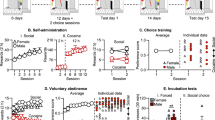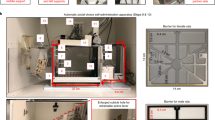Abstract
Rationale and objective
Social factors play a critical role in drug addiction. We recently showed that rats will abstain from methamphetamine, cocaine, heroin, and remifentanil self-administration when given a choice between the addictive drug and operant social interaction. Here, we further characterized operant social interaction by determining the effects of access duration, effort, peer familiarity, and housing conditions. We also determined choice between social interaction vs. palatable food or remifentanil.
Methods
We first trained single-housed male and female rats to lever-press for social interaction with a sex- and age-matched peer. Next, we determined effects of access duration (3.75 to 240 s), effort (increasing fixed-ratio schedule requirements or progressive ratio schedule), peer familiarity (familiar vs. unfamiliar), and housing conditions (single vs. paired housing) on social self-administration. We also determined choice between social interaction vs. palatable food pellets or intravenous remifentanil (0, 1, 10 µg/kg/infusion).
Results
Increasing access duration to a peer decreased social self-administration under fixed ratio but not progressive ratio schedule; the rats showed similar preference for short vs. long access duration. Social self-administration under different fixed ratio requirements was higher in single-housed than in paired-housed rats and higher for a familiar vs. unfamiliar partner in single-housed but not paired-housed rats. Response rates of food-sated rats under increasing fixed-ratio requirements were higher for palatable food than for social interaction. The rats strongly preferred palatable food over social interaction and showed dose-dependent preference for social interaction vs. remifentanil.
Conclusions
We identified parameters influencing the reinforcing effects of operant social interaction and introduce a choice procedure sensitive to remifentanil self-administration dose.




Similar content being viewed by others
References
Ahmed SH (2010) Validation crisis in animal models of drug addiction: beyond non-disordered drug use toward drug addiction. Neurosci Biobehav Rev 35:172–184
Ahmed SH, Koob GF (1998) Transition from moderate to excessive drug intake: change in hedonic set point. Science 282:298–300
Aklin WM, Wong CJ, Hampton J, Svikis DS, Stitzer ML, Bigelow GE, Silverman K (2014) A therapeutic workplace for the long-term treatment of drug addiction and unemployment: eight-year outcomes of a social business intervention. J Subst Abuse Treat 47:329–338
Angermeier WF (1960) Some basic aspects of social reinforcements in albino rats. J Comp Physiol Psychol 53:364–367
Baldwin AN, Banks ML, Marsh SA, Townsend EA, Venniro M, Shaham Y, Negus SS (2022) Acute painrelated depression of operant responding maintained by social interaction or food in male and female rats. Psychopharmacology. https://doi.org/10.1007/s00213-021-06048-7
Beckmann JS, Chow JJ, Hutsell BA (2019) Cocaine-associated decision-making: toward isolating preference. Neuropharmacology 153:142–152
Bossert JM, Adhikary S, St Laurent R, Marchant NJ, Wang HL, Morales M, Shaham Y (2016) Role of projections from ventral subiculum to nucleus accumbens shell in context-induced reinstatement of heroin seeking in rats. Psychopharmacology 233:1991–2004
Bossert JM, Kiyatkin E, Korah H, Hoots JK, Afzal A, Perekopskiy D, Thomas S, Fredriksson I, Blough BE, Negus SS, Epstein DH, Shaham Y (2020) In a rat model of opioid maintenance, the G-protein-biased MOR agonist TRV130 decreases relapse to oxycodone seeking and taking, and prevents oxycodone-induced brain hypoxia. Biol Psychiatry 88:935–944
Canchy L, Girardeau P, Durand A, Vouillac-Mendoza C, Ahmed SH (2021) Pharmacokinetics trumps pharmacodynamics during cocaine choice: a reconciliation with the dopamine hypothesis of addiction. Neuropsychopharmacology 46:288–296
Cantin L, Lenoir M, Augier E, Vanhille N, Dubreucq S, Serre F, Vouillac C, Ahmed SH (2010) Cocaine is low on the value ladder of rats: possible evidence for resilience to addiction. PLoS One 5:e11592
Caprioli D, Venniro M, Zeric T, Li X, Adhikary S, Madangopal R, Marchant NJ, Lucantonio F, Schoenbaum G, Bossert JM, Shaham Y (2015a) Effect of the novel positive allosteric modulator of metabotropic glutamate receptor 2 AZD8529 on incubation of methamphetamine craving after prolonged voluntary abstinence in a rat model. Biol Psychiatry 78:463–473
Caprioli D, Venniro M, Zhang M, Bossert JM, Warren BL, Hope BT, Shaham Y (2017) Role of dorsomedial striatum neuronal ensembles in incubation of methamphetamine craving after voluntary abstinence. J Neurosci 37:1014–1027
Caprioli D, Zeric T, Thorndike EB, Venniro M (2015b) Persistent palatable food preference in rats with a history of limited and extended access to methamphetamine self-administration. Addict Biol 20:913–926
Chow JJ, Beckmann JS (2021) Remifentanil-food choice follows predictions of relative subjective value. Drug Alcohol Depend 218:108369
Chow JJ, Hofford RS, Beckmann JS (2020) Neuronal activity associated with cocaine preference: Effects of differential cocaine intake. Neuropharmacology 184:108441
Comer SD, France CP, Woods JH (1991) Training dose: influences in opioid drug discrimination. Drug discrimination: applications to drug abuse research: 145–161
Deroche-Gamonet V, Belin D, Piazza PV (2004) Evidence for addiction-like behavior in the rat. Science 305:1014–1017
Evans MJ, Duvel A, Funk ML, Lehman B, Sparrow J, Watson NT, Neuringer A (1994) Social reinforcement of operant behavior in rats: a methodological note. J Exp Anal Behav 62:149–156
Fredriksson I, Venniro M, Reiner DJ, Chow JJ, Bossert JM, Shaham Y (2021) Animal models of drug relapse and craving after voluntary abstinence: A review. Pharmacol Rev 73:1050–1083
Grimm J, Hope B, Wise R, Shaham Y (2001) Neuroadaptation - incubation of cocaine craving after withdrawal. Nature 412:141–142
Hackenberg TD, Vanderhooft L, Huang J, Wagar M, Alexander J, Tan L (2021) Social preference in rats. J Exp Anal Behav 115:634–649
Heilig M, Epstein DH, Nader MA, Shaham Y (2016) Time to connect: bringing social context into addiction neuroscience. Nat Rev Neurosci 17:592–599
Heinsbroek JA, Giannotti G, Mandel MR, Josey M, Aston-Jones G, James MH, Peters J (2021) A common limiter circuit for opioid choice and relapse identified in a rodent addiction model. Nat Commun 12:4788
Hodos W (1961) Progressive ratio as a measure of reward strength. Science 134:943–944
Hodos W, Kalman G (1963) Effects of increment size and reinforcer volume on progressive ratio performance. J Exp Anal Behav 6:387–392
Hunt GM, Azrin NH (1973) A community-reinforcement approach to alcoholism. Behav Res Ther 11:91–104
Huskinson SL, Woolverton WL, Green L, Myerson J, Freeman KB (2015) Delay discounting of food by rhesus monkeys: cocaine and food choice in isomorphic and allomorphic situations. Exp Clin Psychopharmacol 23:184–193
Johanson CE (1975) Pharmacological and environmental variables affecting drug preference in rhesus monkeys. Pharmacol Rev 27:343–355
Kliner DJ, Lemaire GA, Meisch RA (1988) Interactive effects of fixed-ratio size and number of food pellets per fixed ratio on rats’ food-reinforced behavior. Psychol Rec 38:121–143
Koffarnus MN, Woods JH (2008) Quantification of drug choice with the generalized matching law in rhesus monkeys. J Exp Anal Behav 89:209–224
Latane B, Nesbitt P, Eckman J, Rodin J (1972) Long-and short-term social deprivation and sociability in rats. J Comp Physiol Psychol 81:69
Lenoir M, Serre F, Cantin L, Ahmed SH (2007) Intense sweetness surpasses cocaine reward. PLoS One 2:e698
Lynch WJ, Carroll ME (2001) Regulation of drug intake. Exp Clin Psychopharmacol 9:131
McCarthy D, Davison M (1984) Isobias and alloiobias functions in animal psychophysics. J Exp Psychol Anim Behav Process 10:390
Negus S, Banks M (2021) Confronting the challenge of failed translation in medications development for substance use disorders. Pharmacol Biochem Behav: 17364. https://doi.org/10.1016/j.pbb.2021.173264
Pickens CL, Airavaara M, Theberge F, Fanous S, Hope BT, Shaham Y (2011) Neurobiology of the incubation of drug craving. Trends Neurosci 34:411–420
Reiner DJ, Lofaro OM, Applebey SV, Korah H, Venniro M, Cifani C, Bossert JM, Shaham Y (2020) Role of projections between piriform cortex and orbitofrontal cortex in relapse to fentanyl seeking after palatable food choice-induced voluntary abstinence. J Neurosci 40:2485–2497
Richardson NR, Roberts DC (1996) Progressive ratio schedules in drug self-administration studies in rats: a method to evaluate reinforcing efficacy. J Neurosci Methods 66:1–11
Saville DJ (1990) Multiple comparison procedures: the practical solution. Am Stat 44:174–180
Schwartz LP, Kim JS, Silberberg A, Kearns DN (2017) Heroin and saccharin demand and preference in rats. Drug Alcohol Depend 178:87–93
Stolerman IP, Childs E, Ford MM, Grant KA (2011) Role of training dose in drug discrimination: a review. Behav Pharmacol 22:415–429
Templer VL, Wise TB, Dayaw KIT, Dayaw JNT (2018) Nonsocially housed rats (Ratus norvegicus) seek social interactions and social novelty more than socially housed counterparts. J Comp Psychol 132:240
Thomsen M, Barrett AC, Negus SS, Caine SB (2013) Cocaine versus food choice procedure in rats: environmental manipulations and effects of amphetamine. J Exp Anal Behav 99:211–233
Townsend EA, Negus SS, Caine SB, Thomsen M, Banks ML (2019) Sex differences in opioid reinforcement under a fentanyl vs. food choice procedure in rats. Neuropsychopharmacology 44:2022–2029
Townsend EA, Schwienteck KL, Robinson HL, Lawson ST, Banks ML (2021) A drug-vs-food " choice " self-administration procedure in rats to investigate pharmacological and environmental mechanisms of substance use disorders. J Neurosci Methods 354:109110
Vanderhooft L, Tan L, Hackenberg TD (2019) Demand for social contact in rats: toward a quantitative analysis of social reinforcement value. Mex J Behav Anal 45:330–358
Varlinskaya EI, Spear LP (2008) Social interactions in adolescent and adult Sprague-Dawley rats: impact of social deprivation and test context familiarity. Behav Brain Res 188:398–405
Venniro M, Banks ML, Heilig M, Epstein DH, Shaham Y (2020a) Improving translation of animal models of addiction and relapse by reverse translation. Nat Rev Neurosci 21:625–643
Venniro M, Caprioli D, Zhang M, Whitaker LR, Zhang S, Warren BL, Cifani C, Marchant NJ, Yizhar O, Bossert JM, Chiamulera C, Morales M, Shaham Y (2017) The anterior insular cortex–>central amygdala glutamatergic pathway Is critical to relapse after contingency management. Neuron 96(414–427):e8
Venniro M, Panlilio LV, Epstein DH, Shaham Y (2021) The protective effect of operant social reward on cocaine self-administration, choice, and relapse is dependent on delay and effort for the social reward. Neuropsychopharmacology 46:2350–2357
Venniro M, Russell TI, Ramsey LA, Richie CT, Lesscher HMB, Giovanetti SM, Messing RO, Shaham Y (2020b) Abstinence-dependent dissociable central amygdala microcircuits control drug craving. Proc Natl Acad Sci 117:8126–8134
Venniro M, Russell TI, Zhang M, Shaham Y (2019) Operant social reward decreases incubation of heroin craving in male and female rats. Biol Psychiatry 86:848–856
Venniro M, Shaham Y (2020) An operant social self-administration and choice model in rats. Nat Protoc 15:1542–1559
Venniro M, Zhang M, Caprioli D, Hoots JK, Golden SA, Heins C, Morales M, Epstein DH, Shaham Y (2018) Volitional social interaction prevents drug addiction in rat models. Nat Neurosci 21:1520–1529
Venniro M, Zhang M, Shaham Y, Caprioli D (2017b) Incubation of methamphetamine but not heroin craving after voluntary abstinence in male and female rats. Neuropsychopharmacology 42:1126–1135
Woolverton WL, Anderson KG (2006) Effects of delay to reinforcement on the choice between cocaine and food in rhesus monkeys. Psychopharmacology 186:99–106
Woolverton WL, Rowlett JK (1998) Choice maintained by cocaine or food in monkeys: effects of varying probability of reinforcement. Psychopharmacology 138:102–106
Zimmer BA, Oleson EB, Roberts DC (2012) The motivation to self-administer is increased after a history of spiking brain levels of cocaine. Neuropsychopharmacology 37:1901–1910
Funding
This research was supported by the Intramural Research Program of NIDA, a grant from NIDA [DA047976] (MV), and support from the NIH CCB fellowship (JJC & NJB).
Author information
Authors and Affiliations
Contributions
JJC, NJB, MV, DTL, and YS conceptualized the research. JJC, NJB, JMC, and MO performed the research and collected the data. JJC, JMC, and YS analyzed the data. JJC, NJB, and YS wrote the manuscript. All authors provided editorial comments and approved of the final version.
Corresponding authors
Ethics declarations
Conflict of interest
The authors declare no competing interests.
Additional information
Publisher's note
Springer Nature remains neutral with regard to jurisdictional claims in published maps and institutional affiliations.
Supplementary Information
Below is the link to the electronic supplementary material.
Rights and permissions
About this article
Cite this article
Chow, J.J., Beacher, N.J., Chabot, J.M. et al. Characterization of operant social interaction in rats: effects of access duration, effort, peer familiarity, housing conditions, and choice between social interaction vs. food or remifentanil. Psychopharmacology 239, 2093–2108 (2022). https://doi.org/10.1007/s00213-022-06064-1
Received:
Accepted:
Published:
Issue Date:
DOI: https://doi.org/10.1007/s00213-022-06064-1




